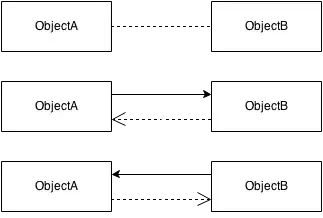I'm designing an object dependency graph of my program and one ambiguity between design variants appears from time to time.
Imagine two objects having a reference to each other. Obviously, at least one reference should be assigned after object's initialization (for example, through a subscription method) and another one optionally can be a direct dependency.
Here's an object diagram

I'm not sure I've used correct UML, so here's my description:
1) Both objects have subscription/binding methods. Usage:
A a = new A();
B b = new B();
a.Set(b);
b.Set(a);
2) ObjectB is a component of ObjectA:
A a = new A(new B());
// somewhere, possibly in a's method :
b.Set(a);
3) Third is actually an opposite of the second, no need to explain.
In my situation I can use any of these and my program will work, but I want some theoretical reasons. Can they be found?